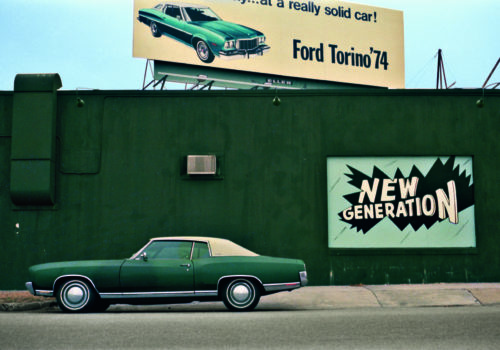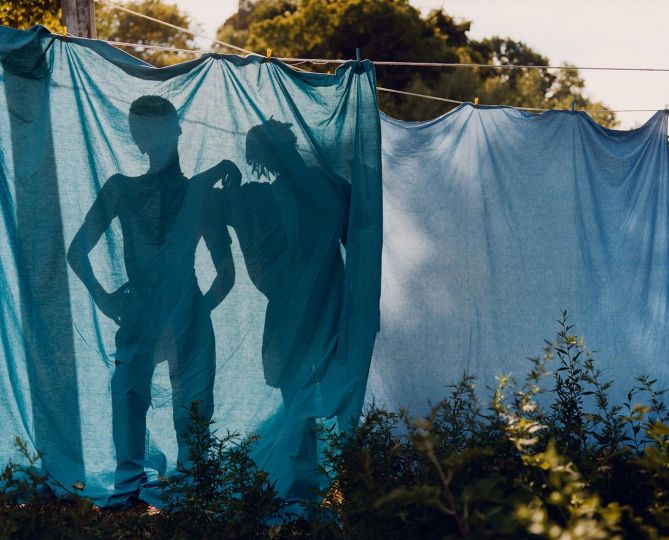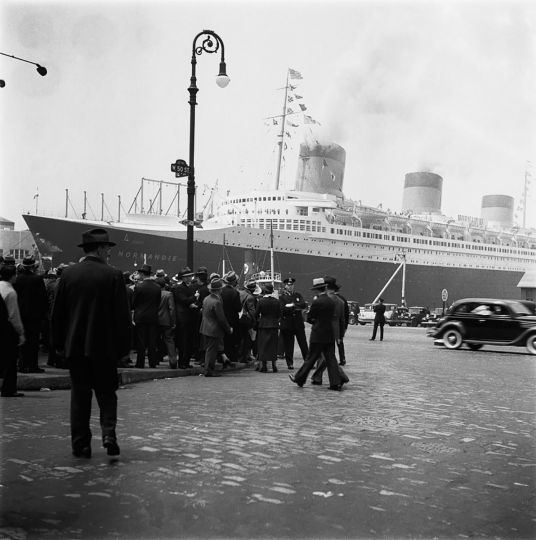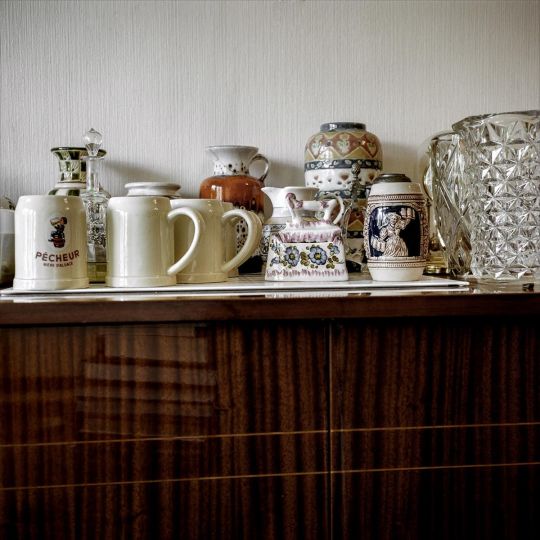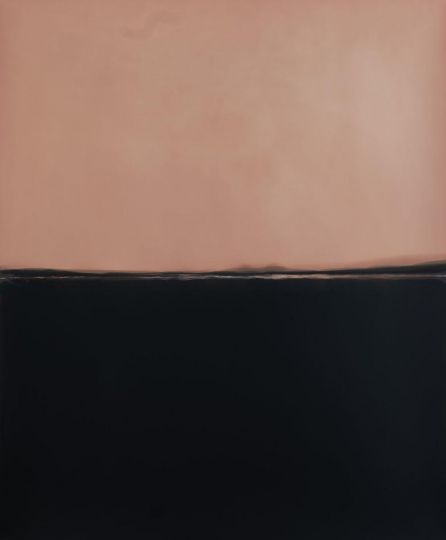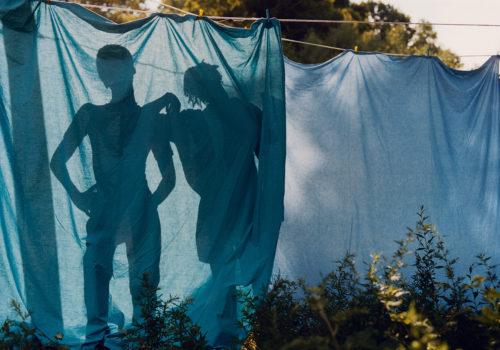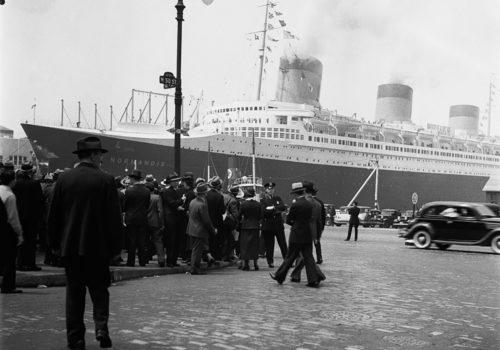A match made in heaven between car and camera is celebrated at the Fondation Cartier with a combination of great pictures and wheels. The exhibition tells a parallel story, full of interchanges, that takes us from a dream object to its impact on human societies and the planet.
The outline of a sedan traces a shapely curve conducive to daydreaming and invites a caress full of childlike wonder. Yasuhiro Ishimoto’s series Snow and Car, which opens one section of the exhibition, is a source of curious pleasure often aroused by the contemplation of an automobile. This pleasurable emotion is here reinforced by the thin blanket of snow covering these cars parked in Chicago streets, sometime between 1948 and 1952, that gives emphasis to their bodies, which are a product of human ingenuity. The observer discovers the unmistakable architecture of the object: from the rims and the doors to the glossy body and rearview mirrors, to the windshields that reflect light and the wheels that encapsulate the promise of future travel.
This is one of the possible readings of Autophoto, an extraordinary exhibition envisioned by the art publisher Xavier Barral and the photographer Philippe Séclier. The two friends brought together some 450 works on the theme of the car, dating from the early twentieth century through today. They have uncovered some little gems and some great treasures, assembled in a perfect scenography, which reproduces the outline of a racetrack. “This is the first exhibition in the world on the subject, and I am glad that it is taking place right here, since France is the birthplace of both the automobile and photography,” reminds us Xavier Barral. It is true that Nicéphore Niépce, the inventor of photography, is also the inventor of the first internal combustion engine, hence the obvious connection between the camera and the car. “The history of the automobile is also the history of photography,” insists the photographer Bernard Plossu. “They go hand in hand; they are the same age!”
A photographic object par excellence
An object of fascination and dreams, the car has naturally become a photographic object par excellence. William Eggleston, who was present at the exhibition opening, shows this object from different angles, in 1970s’ vivid color: the roof of a green Cadillac stands out against the blue sky of New Mexico; a young woman is sipping soda through a straw in front of a red car with a white roof; a Ford Torino is captured next to a billboard advertising its reliability. Emblems of a bygone era, these cars resemble toys with their candy-colored bodies. Eggleston turns them into fashion icons, but of a former fashion when the automobile signified a certain lifestyle: one used to watch a movie at a drive-in while eating a burger or kissing one’s sweetheart.
A car was the owners’ pride and joy. Sylvie Meunier and Patrick Tourneboeuf collected 196 amateur gelatin silver prints of Americans posing with their cars in a series they titled American Dream. The subjects in Seydou Keïta’s and Malick Sidibé’s African photos strike similar poses. One can read in these images the delight of ownership and a sort of complicity between the drivers and their vehicles, as if their car were the most beautiful in the world—something the photographer gets a kick out of highlighting.
Some like to snap pictures of celebrities behind the wheel, like Edward Quinn who photographed Françoise Sagan in her Jaguar or Alain Delon driving a Ferrari with Jane Fonda.
Others celebrate speed. On June 26, 1912, Jacques Henri Lartigue immortalized a Delga racing at the Grand Prix de l’Automobile Club de France in Dieppe. He produced a striking image at a point when, caught at high velocity, the racetrack seems to bend while the spectators appear to lean backwards, as if literally twisted by the passage of the racecar. Man Ray, on the other hand, delighted in capturing the racecar driven by Francis Picabia in 1924, and went even further in creating effects of distortion. In 1982, the photographer Bernard Asset climbed onto the back of Alan Prost’s Formula One just as the driver was doing a test run. One of the resulting photographs frames the ribbon of the track winding up toward the horizon and the driver’s helmet at the photographer’s feet. Taken at maximum shutter speed to preserve the figures without losing the feel of the race, the almost blurry image gives the viewer a sense of velocity.
On the road
In contrast to celebratory photography, some images sublimate the presence of the car. Germaine Krüll is captivated by traffic jams at the Place de l’Étoile and Avenue de la Grande Armée in Paris in 1926. Brassaï observes the headlights blending with the city lights on the Place de l’Opéra or the Grands Boulevards in 1934–5. Doisneau in turn makes cars dance with two stunning photographs in which he experimented with long exposures: in one, a passing car turns into a blur, while in another, the headlights leave behind a trail of luminous circles in the night.
New landscapes are born with the advent of the automobile, as well as new pictures for landscape lovers. The car has launched a cultural revolution. It inspired the Beat Generation, and Jack Kerouac’s On the Road. In photography, Robert Frank immortalized this Wanderlust and love of the open road in his famous series The Americans. Others followed. The Frenchman Bernard Plossu hit the road in Mexico in 1966. The American John Divola took a picture of his dog running alongside his car in an American desert. The Japanese Daido Moriyama drove around the Island of Okinawa. All these photographers made spur-of-the-moment portraits combining encounters with travelers and roadside views, and blending the excitement of the voyage with the hardness of the asphalt.
The automobile also introduced a new format: the car window inscribed within the natural frame while adding a new one. Lee Friedlander has made it his trademark. In his series America by Car, he uses it whenever he photographs the world passing outside his windshield: the world of rest stops, roadside attractions, and shopping centers scattered in the outskirts of large cities. The Mexican Oscar Fernando Gomez uses the same technique. Working as a cab driver, he captures what he sees along his route in the poorest neighborhoods in the State of Nuevo Léon where he spent his childhood. As he puts it, he thus “makes a self-portrait of sorts.” The results are remarkable pictures of the life in that impoverished region of Mexico: in one, you see a cow, in another a tire dump, or yet a youngster posing in front of graffiti. The car becomes a privileged viewpoint, like in Scorsese’s Taxi Driver, and generates images that would not have been otherwise possible.
Landscapes
But the car is not just the photographer’s vehicle of choice; it is also a world-changer, giving rise to urban zones into which cars spill from highway ramps. Edward Burtynsky photographed the highway circling Shanghai in China. On the facing wall, the viewer encounters Robert Adams’s images denouncing the construction of freeways, turnpikes, as well as bargain superstores in 1970s Colorado. These images are disturbing and frightening; the oversize concrete buildings destined to house motorized vehicles haunt the viewer with their menace of chaos, noise, and pollution.
Occasionally, however, these structures become the subject of daydreams. Hans-Christian Schink glorifies an overpass using carefully controlled light effects to emphasize the colossal dimensions of the architecture. Further on, Ray K. Metzker’s high-contrast black-and-white photographs foreground the magnificent symmetry of cars parked in Philadelphia parking lots. Walker Evans, in turn, contemplates whatever goes on under foot: road markings. In a series of Polaroids taken in the 1970s, he captures here an arrow, there a broken line or a pedestrian crossing, constructing a kaleidoscopic vision of new types of urban traces.
Social impact
In addition to the havoc it has wreaked on the landscape, the car has also disrupted human lifestyles and generated new habits. The lower-level portion of the exhibition at the Fondation Cartier explores these issues at some length. First viewed as an almost organic body, the automobile is dissected by Robert Frank during his visit to a Ford factory in Detroit in 1955. He observes how the workers trim, cut, and weld parts of the machine. In the early 2000s, the photographer Valérie Belin created carefully staged close-ups of engines, which inspired the curators to comment that the car engine resembles the human heart.
The automobile is also a vehicle for stories: there are Britons interviewed by Martin Parr who describe how they use their Volvos or how they hate the bad manners of other drivers. There are Swedish teenagers who enjoy tinkering with jalopies and then climb onto the hood of a car rolling in front of Martin Borgen’s lens. There is a truck loaded with people and parcels in the middle of a desert on the Chad–Libyan border, captured by Raymond Depardon. There are couples kissing in cars in the pictures of Elliott Ewitt and Bruce Davidson. There are traditional portraits of newly-weds about to take off for their honeymoon in a series of photographs assembled by Rosângela Rennó. There are darker stories, too: in Mexico, Alejandro Cartagena photographs pickup trucks from above, revealing flatbeds transporting seasonal workers, sometimes piled one on top of the other, to construction sites. Justine Kurland portrays social outcasts in the United States as she travels across the country with her son, while Mary Ellen Mark shows families asleep in their cars. Oscar Monzon, in turn, emphasizes the predatory side of cars in his series Karma, while Kurt Caviezel becomes himself a predator as he captures the interiors of cars stopped at a traffic light in his Red Light series.
Jacqueline Hassink’s series is even more violent in the reduction of a being into an object. Over the course of six years, scouring automobile shows in seven cities across three continents, the artist photographed “car girls,” the “hostesses” hired to pose with cars. Paris, Tokyo, New York… Car manufacturers try to arouse the customer’s fantasies by combining the car object and the sexual object. Photographed surreptitiously, the “car girls” recover their humanity in Jacqueline Hassink’s eponymous series: we see young women feeling out of place, smiles glued to their faces—beneath their alluring exterior, one can sense disenchantment.
Accidents, crashes, scrap, and salvage
Next to luxury cars sold at car shows, we encounter the other side of the story: car wrecks and junkyards. The Swiss policeman Arnold Odermatt specializes in photographing, with surgical precision, the sites of car crashes. His images convey with clarity the final screeching of the tires before the collision, the shock the car body received on impact, and the damage inflicted on the object. Next we see scrapped cars piled up in junkyards. There are mounds of glass, such as those captured by Eric Aupol, showing amorphous masses of contorted windshields. In Peter Lippmann’s photographs, derelict front-wheel-drive Citroëns sit abandoned in a forest, slowly engulfed by creeping ivy.
The Japanese photographer Hiroshi Sugimoto goes even further in documenting the demise of cars. On his walks on a New Zealand beach in 1990, he would come across all sorts of bizarre junk. He realized these were parts of cars built in the 1960s and abandoned by the seaside not long thereafter. Corroded by the waves, these cars have disintegrated into strange pieces, like the vestiges of an extinct civilization. “The sight of crafted objects rotting away is at once dreadful and beautiful,” Sugimoto describes in the prologue to On the Beach. “Time foments corrosion. It doesn’t take long for civilization to decay. Just a few decades are enough for a car, one symbol of our modern civilization, to decompose into nothing.” The photographer turns these bizarre objects into black-and-white canvases where the viewer’s eye wanders among abstract forms evoking a kitchen utensil or a gardening tool excavated by an archeologist from the silt.
Across the room, the Fondation Cartier brings the viewer up for air, offering some space of hope. Melle Smets and Joost van Onna traveled to Ghana on the trail of a project aiming at building new vehicles from recycled car parts. Within a few months, they managed to build, with the help of the residents of a disadvantaged area of the country, Turtle 1—a car that drives “slowly, but surely,” and that the king of Ghana himself decided to test-drive in his own private gardens, giving it the supreme seal of approval.
The stuff dreams are made of
Whether you’re the king of Ghana or a simple exhibition visitor, you are likely to succumb to the allure of the car. One exhibition room it devoted to the realm of dreams. Bathed in dimmed light, the photographs of the Swiss writer Ella Maillart retrace Asian exploration in the 1930s behind the wheel of a Ford. Next, the viewer is invited to follow the tire tracks of Nicolas Bouvier. All these images exude a sense of adventure, where the car features as a four-wheeled accomplice, or even a lover, that conjures up ever-new dreams and desires, and promises new discoveries.
In the middle of this room, off to one side, we find a hidden gem. Xavier Barral admits that it is being exhibited for the very first time. These are stereoscopic plates from an expedition sponsored by the tire manufacturer Michelin in 1930 and exploring the roads of five continents. Each tiny image is illuminated from below—an exhaustible material for our imagination: a rocky road in a remote corner of China; a pothole puddle in Argentina; a dirt road somewhere in Africa. These landscapes are empty and untamed. At the time, the planet was not yet covered with a network of roads, and the car was only taking the first steps in its breathtaking conquest of the world and humankind. And photography, too, was just starting out.
Jean-Baptiste Gauvin
Jean-Baptiste Gauvin is a journalist, writer, and stage director. He lives and works in Paris.
Autophoto
April 20 to September 24, 2017
Fondation Cartier pour l’art contemporain
261 Boulevard Raspail
75014 Paris
France

